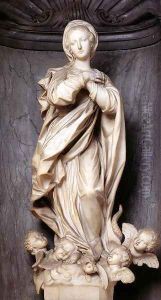Francesco Maria Schiaffino Paintings
Francesco Maria Schiaffino was an Italian sculptor of the Rococo period, born in 1688 in Genoa, Italy. He was a leading figure in the Genoese school of sculpture and is best remembered for his elegant and dynamic works, which combine technical prowess with a lively sense of movement and emotional expression.
Schiaffino was born into a family of sculptors and architects, which undoubtedly influenced his early training and career path. He learned the craft from his father, Giovanni Battista Schiaffino, who was also a noted sculptor. Francesco Maria further honed his skills under the tutelage of Filippo Parodi, another prominent Genoese sculptor of the time.
In his early career, Schiaffino produced numerous religious works, including statues and reliefs for churches in Genoa and its surroundings. His talent quickly gained recognition, and he was commissioned to create sculptures for various religious and secular buildings. Schiaffino's works were characterized by their fluid lines, intricate details, and a sense of movement that was typical of the Rococo style, which was gaining popularity across Europe during his lifetime.
One of his most notable projects was the decoration of the Chapel of Our Lady of the Assumption in the church of Santa Maria Assunta di Carignano in Genoa, where he worked alongside his brother, Giuseppe Schiaffino. Together, they created a harmonious ensemble of sculptures that remain an important example of Genoese Baroque art.
As his reputation grew, Schiaffino was involved in larger and more prestigious projects. He produced works for the Royal Palace of Genoa and other noble residences, showcasing his ability to work on a grand scale. His sculptures often featured allegorical figures, cherubs, and saints, rendered with a sense of grace and vivacity.
Francesco Maria Schiaffino's influence extended beyond his own works. He trained several apprentices, contributing to the spread of his style and techniques. His impact on the Genoese artistic landscape was significant, and his legacy continued through the work of his students.
Schiaffino's contributions to the arts were recognized in his time, and his sculptures are still admired today for their technical skill and artistic beauty. He passed away in 1763 in Genoa, leaving behind a body of work that continues to be studied and appreciated by art historians and enthusiasts alike.
